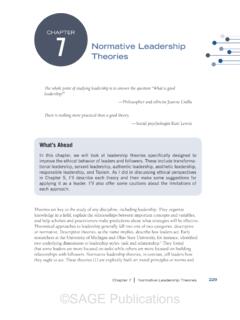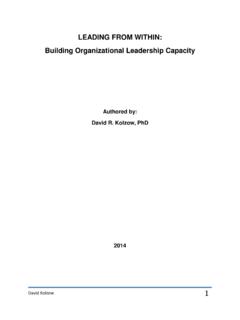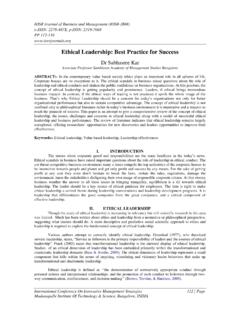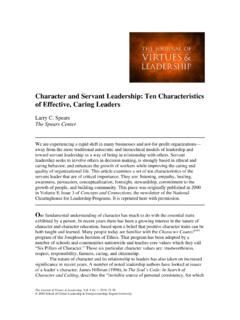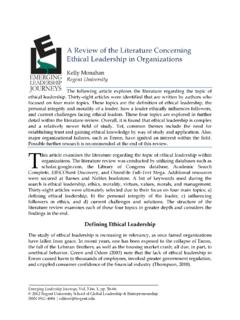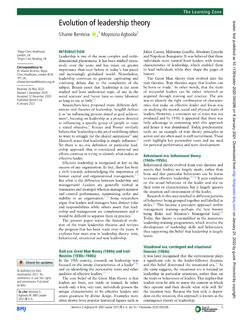Transcription of Leadership, Leadership Styles, and Servant Leadership
1 Franco GandolfiVice Chancellor Manipal International University (MIU) Nilai, Negeri Sembilan - 71800 MalaysiaSeth StoneAdjunct Professor Regent University Virginia Beach, Virginia 23464, USAL eadership, Leadership Styles, and Servant LeadershipFranco Gandolfi and Seth StoneAbstractResearch on Leadership has become a prominent scholarly and professional pursuit in an ever-changing, highly complex, and multi-dimensional globalized world. In spite of an over-abundance of scientific and anecdotal work, a myriad of Leadership -related questions have remained unanswered. The purpose of this conceptual paper is to demystify Leadership and to bring clarity to what Leadership and Leadership styles are, identify critical attributes of effective Leadership , and demonstrate that Servant Leadership meets the criteria for effective : Leadership , Leadership Styles, Servant LeadershipINTRODUCTIONT here perhaps has never been a more important time to shine the spotlight of the wide-ranging discussion on Leadership to the style of Servant Leadership .
2 The lists of potential reasons for such a shift are many. First, it requires little more than a brief scan of daily news headlines to recognize that the world is entrenched in a Leadership crisis. Second, Leadership has become increasingly more difficult, complex, and multi-faceted for organizations of all types globally, thereby bringing new questions and challenges regarding the best type of leader, which ironically has done little more than cloud the overarching discussion on Leadership (Gandolfi & Stone, 2016). Further, despite the significant body of literature on Leadership , it continues to remain one of the most misunderstood business phenomena to date (Gandolfi, 2016). If the goal is to understand the consequences of Leadership and its various styles, specifically Servant Leadership , it is important first to bring clarity to what Leadership is and why it is such a pivotal there has been substantial research completed and authenticated with regard to what are now considered mainstream styles of accepted Leadership , such as democratic, transactional, and transformational Leadership , there is very little research on Servant Leadership by way of actual comparison (Gandolfi, Stone, & Deno, 2017).
3 Robert Greenleaf (1970) had brought Servant Leadership into the corporate spotlight, but not without resistance and much skepticism, as it took nearly thirty years to begin garnering any meaningful attention from Leadership experts and scholars (Gandolfi et al., 2017). At this juncture, in the midst of trying to understand Leadership itself, it is imperative to simultaneously understand what Servant Leadership is and is not (Brown & Bryant, 2015), as a means to make a compelling case for its application alongside other accepted Leadership of Management ResearchVol. 18, No. 4, 2018, pp. 261-269262 Journal of Management Researchleadership has become a systemic issue on a global level, thus it is not surprising to see more and more cases such as these to arise. In fact, a Gallup study that examined the relationships between employees and their managers found that of 7,200 people surveyed who left their jobs; roughly half did so because of a bad manager (Snyder, 2015).
4 This insight shows that no organization or industry is immune from poor Leadership leading some to believe that it could even be characterized as ubiquitous (Gandolfi & Stone, 2016). Poor Leadership takes its toll on every imaginable stakeholder from those inside and outside the organizations. This reality places Leadership in a state of crisis on a global level. Therefore, there must be a sense of urgency in the uncovering of the most desirable and effective methods for leading a leader chooses to behave, or in more academic terminology how a leader accesses a repertoire of styles, impacts the various stakeholders profoundly. Chaleff (2009) posits that all important social accomplishments require complex group efforts and, thus, Leadership and followership are both necessary in the pursuit of a common purpose.
5 This inherently forces leaders to emerge, but the type of leader that rises to the top will indeed make or break the organization. From a purely organizational perspective, without clearly drawn maps to the future, an organization tends to be hamstrung by its past (Miller, 1995). It is the responsibility of Leadership to move organizations to a desired future state without losing sight of those who will get it there. It is an extremely difficult balancing act. However, it is what makes Leadership so incredibly significant and demonstrates why the chosen Leadership style is a decision with the highest of stakes the global community faces Leadership AND Leadership STYLET here are countless definitions of Leadership that exist. Yet, a proper understanding of why Leadership is so significant and why the chosen Leadership style is so important becomes The purpose of this paper is to help bring clarity both to what Leadership and Leadership styles actually are, as well as identify critical attributes of effective Leadership .
6 The objective is to demonstrate that Servant Leadership meets the criteria for effective Leadership and is potentially highly desirable for organizations of all type and industry in the 21st Century and beyond. This paper will begin with a brief explanation of the importance of Leadership , as well as provide working definitions for both Leadership and Leadership styles. It will then distill the key attributes of effective Leadership and make the case that Servant Leadership holds a rightful place amongst other Leadership styles. This is done by providing a historical context, as well as how and why Servant Leadership works and must be applied in today s SIGNIFICANCE OF LEADERSHIPW hile there is much disagreement with regard to what Leadership actually is, the one commonality that can be found across virtually all of the existing Leadership literature is that Leadership is important.
7 While this point may appear rather obvious, it should not be lost on us. The reason being is that when Leadership is ineffective, absent, or toxic the result is that people, organizations, communities, and even entire societies are impacted, sometimes in the most devastating ways (Gandolfi & Stone, 2016). Leadership failures are well-documented and, at times, appear to be the rule, not the exception. Ken Lay of Enron, Dennis Kozlowski of Tyco, and the infamous Bernie Madoff are just a few well-documented business examples that can be pointed to the past few decades alone. More recent examples include the much publicized FIFA Leadership fiasco and the Volkswagen integrity crises and, even more recently, the clear lack of Leadership at the Olympic Games in Brazil. The latter was evidenced by complete Leadership failure both by the athletes who represented their respective countries as well as the local Leadership (Gandolfi & Stone, 2016).
8 There are always lessons and takeaways in the moment that spark discussions on ethics, policies, and even government regulations. However, Leadership problems persist even in spite of these efforts. It appears that poor Volume 18, Number 4 October December 2018 263particularly valuable to introduce working definitions of both Leadership and Leadership style. Gandolfi (2016) asserts that the combination of five components render a potent working definition of Leadership - (i) there must be one or more leaders, (ii) Leadership must have followers, (iii) it must be action oriented with a legitimate (iv) course of action, and there must be (v) goals and objectives. Working from these five criteria, the following definition was selected for the purpose of this article: A leader is one or more people who selects, equips, trains, and influences one or more follower(s) who have diverse gifts, abilities, and skills and focuses the follower(s) to the organization s mission and objectives causing the follower(s) to willingly and enthusiastically expend spiritual, emotional, and physical energy in a concerted coordinated effort to achieve the organizational mission and objectives.
9 (Winston & Patterson, 2006, p. 7)Winston and Patterson (2006) provide a definition as it relates to the components needed for defining Leadership as stated above. Additionally, this definition provides an unequivocal demonstration that Leadership is not one-dimensional. Rather, Leadership requires a deep understanding about the role of people in the ultimate success of the mission and vision of the organization (Gandolfi & Stone, 2016). This assists in moving Leadership out of a theoretical realm into a very tangible and pragmatic space, giving room to explore Leadership styles and how they connect to a definition such as a significant body of research exists addressing various Leadership styles, there is a surprising shortcoming of research examining the notion of a Leadership style (Gandolfi & Stone, 2016). It is almost a forgone assumption that there is general understanding and consensus with regard to what a Leadership style is, which is erroneous and does not serve the greater discussion on Leadership well.
10 Such a lack of clarity could be contributing to the widely disparate views on Leadership (Gandolfi et al., 2017).Buchanan (2013) opines that the world has moved through different phases of Leadership since the early part of the 20th Century. Specifically, there was first the concept of command-and-control that prevailed into the 1980s, which was followed by empower-and-track through the mid 2000 s, and, finally, connect-and-nurture, which is the current approach. While this timeframe may not hold universally true, it provides a high-level justification as to why different Leadership styles have emerged. Additionally, early theories of Leadership had made the assumption that good Leadership was based on traits (Shazia, Anis-ul-Haq, & Niazi, 2014). This led to the notion that leaders are born and not was the well-known psychologist Kurt Lewin and team (1939) who introduced that leaders could be made and were not necessarily just born.
